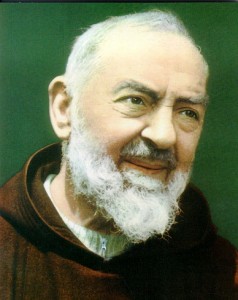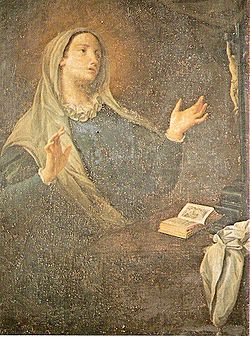The Living Flame Of Love
 Songs of the soul in the intimate communication of loving union with God.
Songs of the soul in the intimate communication of loving union with God.
[powerpress]
1. O living flame of love
that tenderly wounds my soul
in its deepest center! Since
now you are not oppressive,
now consummate! if it be your will:
tear through the veil of this sweet encounter!
2. O sweet cautery,
O delightful wound!
O gentle hand! O delicate touch
that tastes of eternal life and pays every debt!
and pays every debt!
In killing you changed death to life.
3. O lamps of fire! in whose splendors
the deep caverns of feeling,
once obscure and blind,
now give forth, so rarely, so exquisitely,
both warmth and light to their Beloved.
4. How gently and lovingly
you wake in my heart,
where in secret you dwell alone;
and in your sweet breathing,
filled with good and glory,
how tenderly you swell my heart with love.
Here is a fine teaching from Fr. Barron:

My Soul is a Candle
My soul is a candle that burned away the veil;
only the glorious duties of light I now have.
The sufferings I knew initiated me into God.
I am a holy confessor for men.
When I see their tears running across their cheeks
and falling into
His hands,what can I say to their great sorrow
that I too haveknown.
The soul is a candle that will burn away the darkness,
only the glorious duties of love we will have.
The sufferings I knew initiated me into God.
only His glorious cares
I now have.
Tags: alone, darkness, heart, love, my soul is a candle, mystic, mystic of the Church, poems of john of the cross, songs of the soul, st. john of the cross, sufferings, the living flame of love
This entry was posted on Saturday, December 14th, 2013 at 12:33 am
You can follow any responses to this entry through the RSS 2.0 feed.
Episode 21 Beginning to Pray: Â St. Hildegard von Bingen and “The Iron Mountain”

[powerpress]
From Dr. Lilles’ “Beginning to Pray” blog site:
September 17 is the feast of St. Hiildegard of Bingen. She lived from 1098-1179. A Benedictine Nun, at the age of 42, she was given visions and commanded rise up and cry out what she saw. She obeyed and produced a set of writings known today as Scivias.
Her first vision is of a hidden mountain, the mountain of God’s throne, an iron mountain of immutable justice hidden in divine glory. A purifying Fear of the Lord contemplates this splendor. Not the kind of fear that pulls away to protect itself. Rather the kind of fear that is vigilant and sees the truth. Eyes which gaze with this holy fear can never be satisfied with the merely mediocre. They guard against every form of compromise. The glory they behold demands absolute allegiance, complete surrender, and total humility.
In this description, is St. Hildegard suggesting a way by which we might enjoy the same vision she has shared in? This is no exercise in esoteric navel gazing. Her vision demands a journey beyond our own self-pre-occupation and into real friendship with God, a friendship protected by the strength of divine justice. She sees the truth in a way that demands an ongoing conversion of life.
She is well-formed in St. Benedict’s conversatio morum. The mountain she sees is not a truth we scrutinize so much as the truth that scrutinizes us: a scrutinizing of all our thoughts and actions in light of the Gospel. The truth she beholds demands repentance from the lack of justice we allow ourselves to slip into. The iron mountain she contemplates renders futile every effort to conform the Gospel to our own ways and invites us to be transformed by its just demands.
Today, where all kinds of cruelty are so easily excused and any form of self-indulgence so readily lifted up to the level of a fundamental human right, we need to rediscover the shadow of the iron mountain from which St. Hildegard cries out to us. Only under the glory of this mountain can we find the peace that the Lord has come to give. Only in the blinding light into which Holy Fear gazes can we find the humility to love one another the way Christ has loved us.
Dr. Anthony Lilles is a Catholic husband and father of three teaching Spiritual Theology at St. John Vianney Theological Seminary. He  teaches spiritual theology and spiritual direction to transitional deacons, and the spiritual classics to the men who enter the Spirituality Year, a year of prayer in preparation for seminary formation.  He is the author of the “Beginning to Pray”  catholic blog spot.
For other episodes in the series visit the Discerning Hearts page for Dr. Anthony Lilles
The music that is used comes from 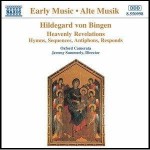
This the text we use  for our readings comes from:
Tags: Anthony Lilles, catholic, catholic podcast, catholic prayer, cathollc spirituality, father, mystic, mystic of the Church, spiritual direction, Spirituality Year, st hildegard of bingen
This entry was posted on Tuesday, September 17th, 2013 at 4:16 am
You can follow any responses to this entry through the RSS 2.0 feed.
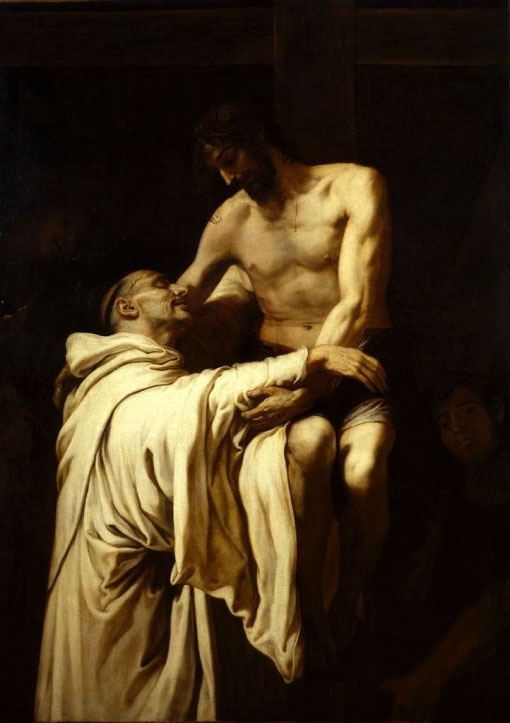 St. Bernard of Clairvaux, a great mystical doctor of the Church. What a heart for Jesus and the Blessed Virgin (I’m sure he still has).
St. Bernard of Clairvaux, a great mystical doctor of the Church. What a heart for Jesus and the Blessed Virgin (I’m sure he still has).
That is curiosity.
That is vanity.
–
That is love.”
St. Bernard of Clairvaux, was a Cisterian monk, who lived in France in the 12th century. Living at a time when the great gothic cathedrals where born, St. Bernard, advocated for simplicity and austerity in life. He was concerned about the temptations of worldly things and desires. He wished to focus solely on the love of Christ and the Blessed Mother; everything else was folly.
To read more about the details of his life you can visit here.
What captures my heart is his legacy of prayer and spiritual writings. He truly deserves the title Doctor of the Church. What a feast he has left us! Pope John Paul II has said that if we wish to learn to pray, look to the Mystical Doctors…he truly is one of those special souls. There is so much, where can one begin? Begin with Mary. Ask the Blessed Mother, she will lead you through his teachings.
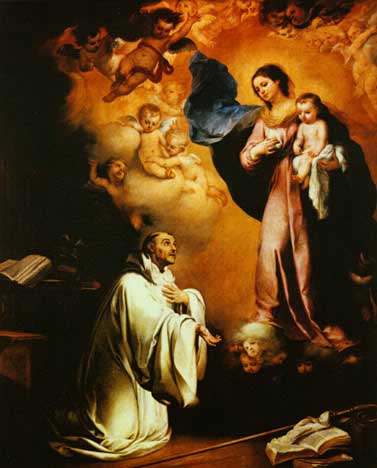 St. Bernard of Clairvaux composed the famous prayer to the Most Blessed Virgin Mary known as The Memorare
St. Bernard of Clairvaux composed the famous prayer to the Most Blessed Virgin Mary known as The Memorare
REMEMBER, O most gracious Virgin Mary, that never was it known that anyone who fled to thy protection, implored thy help, or sought thy intercession was left unaided. Inspired with this confidence, I fly to thee, O Virgin of virgins, my Mother; to thee do I come; before thee I stand, sinful and sorrowful. O Mother of the Word Incarnate, despise not my petitions, but in thy mercy hear and answer me. Amen.
St. Bernard on the Blessed Mother
St. Bernard on Holy Repentance
–
Highly recommended reading introduction to St. Bernard would be – “The Fulfillment of All Desire” by Ralph Martin
–
Tags: blessed mother, blessed virgin mary, Church, discerning heart, doctor of the church, emmaus road, holy repentance, intercession, love, monastic life, mystic, mystic of the Church, ralph martin, st bernard of clairvaux
This entry was posted on Monday, August 20th, 2012 at 12:40 am
You can follow any responses to this entry through the RSS 2.0 feed.
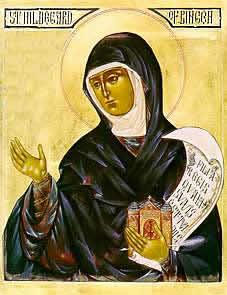 December 16, 2011. (Romereports.com)
December 16, 2011. (Romereports.com)
Benedict XVI is set to appoint Hildegard of Bingen as a Doctor of the Church in October of 2012. She was a German Benedictine nun and was known for her visions and prophecies.
Hildegard of Bingen lived in the twelfth century. In addition to being a nun, she was a composer, philosopher, physicist and ecologist. A multi-talented woman, and a pioneer for many of these fields during the Middle Ages.She came from a wealthy family and when she was only eight years old was sent to study in a monastery. She eventually decided to become a nun and later became an abbess.
Her visions and prophecies were recognized by the pope during that time, allowing her to speak about them publicly.
Since she has not been officially canonized, the ceremony is likely to take place before the pope names her as a Doctor of the Church in October.
Benedict XVI dedicated several of his general audiences to this German nun, saying that she “served the Church in an age in which it was wounded by the sins of priests and laityâ€.
Benedict XVI
September 8, 2010Â
“She brought a woman’s insight to the mysteries of the faith. In her many works she contemplated the mystic marriage between God and humanity accomplished in the Incarnation, as well as the spousal union of Christ and the Church. She also explored the vital relationship between God and creation, and our human calling to give glory to God by a life of holiness and virtue.â€So far there are 33 doctors of the Church, only 3 of whom are women. During World Youth Day, Benedict XVI also announced that the Spanish San Juan de Avila would also be appointed as a Doctor of the Church.
With this appointment, the Church recognizes a person’s contribution to Catholic theology, which is still felt despite the passage of time.
Tags: benedict xvi, benedictine, catholic, catholic podcast, catholic prayer, cathollc spirituality, Hildegard of Bingen, mystic of the Church, st hildegard of bingen
This entry was posted on Wednesday, January 4th, 2012 at 8:47 am
You can follow any responses to this entry through the RSS 2.0 feed.
.
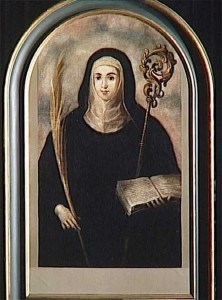 see also Pope Benedict’s teachings on St. Gertrude on the Discerning Hearts Holy Women page
see also Pope Benedict’s teachings on St. Gertrude on the Discerning Hearts Holy Women page
(1256-1302 A.D.) Few men have merited the title, “the Great”; fewer women. I know of only one nun so honored, St. Gertrude of Helfta, a mystic whose spiritual writings have remained influential up to the present.
Nothing is known of this German woman’s family background. When five years old, she was entrusted to the sisters of Helfta Abbey to be educated. From a very young age she gave evidence of her brilliance and quickly outstripped her companions. In her teen years she asked to join the community. Therefore, she probably spent her whole life from childhood on within the abbey walls.
Her love for secular studies made the common life wearisome, pride and vanity ate away at her soul and she soon became an unhappy young woman until Christ appeared to her. The day was branded in her memory, it was in her 26th year, when as she says “in a happy hour, at the beginning of twilight, thou O God of truth, more radiant than any light, yet deeper than any secret thing, determined to dissolve the obscurity of my darkness.” From then on her biographer tells us “she became a theologian instead of a grammarian.” She did not give up her intellectual ardor but now, all her labors were for her sisters, to cure what she termed “the wound of ignorance”. Her many gifts and mystical graces did not prevent her from giving herself wholeheartedly to the common life with its joys and sorrows. In fact many of her special graces came to her as she took part in the ordinary routine of convent life. She felt keenly for those whose burdens involved them in distracting duties, for example those responsible for meeting the debts of the monastery.
She prayed that they might have more time to pray and fewer distractions. The Lord’s answered “It does not matter to me whether you perform spiritual exercises or manual labor, provided only that your will is directed to me with a right intention. If I took pleasure only in your spiritual exercises, I should certainly have reformed human nature after Adam’s fall so that it would not need food, clothing or the other things that man must find or make with such effort.”
Many of her writings are lost, but fortunately she left to the world an abundance of spiritual joy in her book The Herald of Divine Love, in which she tells of the visions granted her by our divine Lord. She wrote this excellent, small book because she was told that nothing was given to her for her own sake only. Her Exercises is an excellent treatise on the renewal of baptismal vows, spiritual conversion, religious vows, love, praise, gratitude to God, reparation, and preparation for death.
She began to record her supernatural and mystical experiences in what eventually became her Book of Extraordinary Grace (Revelation of Saint Gertrude), together with Mechtilde’s mystical experiences Liber Specialis Gratiae, which Gertrude recorded. Most of the book was actually written by others based on Gertrude’s notes. She also wrote with or for Saint Mechtilde a series of prayers that became very popular, and through her writings helped spread devotion to the Sacred Heart (though it was not so called until revealed to St. Margaret Mary Alocoque).
Gertrude is inseparably associated with the devotion to the Sacred Heart. The pierced hear
t of Jesus embodied for her the Divine Love, an inexhaustible fountain of redemptive life. Her visions and insights in connection with the Heart of Jesus are very enlightening. In one such intellectual vision, she perceived the unceasing love of Christ for us in two pulsations of his Heart – one accomplished the conversion of sinners, the other the sanctification of the just. Just as our own faithful heart keeps right on whether we advert to it or not, these pulsations will endure till the end of time despite the vicissitudes of history.
Our Lord wishes people to pray for the souls in purgatory. He once showed Gertrude a table of gold on which were many costly pearls. The pearls were prayers for the holy souls. At the same time the saint had a vision of souls freed from suffering and ascending in the form of bright sparks to heaven.
In one Vision, Our Lord tells Gertrude that he longs for someone to ask Him to release souls from purgatory, just as a king who imprisons a friend for justice’s sake hopes that someone will beg for mercy for his friend. Jesus ends with:
“I accept with highest pleasure what is offered to Me for the poor souls, for I long inexpressibly to have near Me those for whom I paid so great a price. By the prayers of thy loving soul, I am induced to free a prisoner from purgatory as often as thou dost move thy tongue to utter a word of prayer.” (more…)
Tags: benedictine, catholic, catholic podcast, catholic prayer, cathollc spirituality, devotion, family, jesus christ, love, mystic of the Church, mystical experiences, sacred heart, sacred heart of jesus, spiritual exercises, spiritual writings, st gertrude, women of the middle ages
This entry was posted on Wednesday, November 16th, 2011 at 2:30 am
You can follow any responses to this entry through the RSS 2.0 feed.
St. Paul of the Cross quotes:
When you feel the assaults of passion and anger, then is the time to be silent as Jesus was silent in the midst of His ignominies and sufferings.-St. Paul of the Cross
It is very good and holy to consider the passion of our Lord, and to meditate on it, for by this sacred path we reach union with God. In this most holy school we learn true wisdom, for it was there that all the saints learned it.-St. Paul of the Cross
Therefore, be constant in practicing every virtue, and especially in imitating the patience of our dear Jesus, for this is the summit of pure love. Live in such a way that all may know that you bear outwardly as well as inwardly the image of Christ crucified, the model of all gentleness and mercy. For if a man is united inwardly with the Son of the living God, he also bears his likeness outwardly by his continual practice of heroic goodness, and especially through a patience reinforced by courage, which does not complain either secretly or in public. Conceal yourselves in Jesus crucified, and hope for nothing except that all men be thoroughly converted to his will.-St. Paul of the Cross
I want to set myself on fire with love…I want to be entirely on fire with love…and I want to know how to sing in the fire of love.-St. Paul of the Cross
Look upon the face of the Crucified, who invites you to follow Him. He will be a Father, Mother–everything to you.-St. Paul of the Cross
I hope that God will save me through the merits of the Passion of Jesus. The more difficulties in life, the more I hope in God. By God’s grace I will not lose my soul, but I hope in His mercy.-St. Paul of the Cross
Christ Crucified is a work of love. The miracle of miracles of love. The most stupendous work of the love of God. The bottomless sea of the love of God, where virtues are found, where one can lose oneself in love and sorrow. A sea and a fire or a sea of fire. The most beneficial means of abandoning sin and growing in virtue, and so in holiness.-St. Paul of the Cross
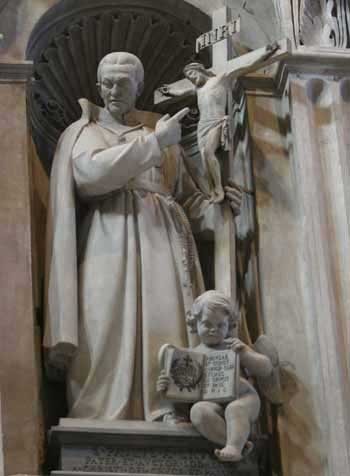 At holy Communion I had much sweetness. My dear God gave me infused knowledge of the joy which the soul will have when we see him face to face, when we will be united with Him in holy love. Then I felt sorrow to see Him offended and I told Him that I would willingly be torn to pieces for a single soul. Indeed, I felt that I would die when I saw the loss of so many souls who do not experience the fruit of the Passion of Jesus.-St. Paul of the Cross
At holy Communion I had much sweetness. My dear God gave me infused knowledge of the joy which the soul will have when we see him face to face, when we will be united with Him in holy love. Then I felt sorrow to see Him offended and I told Him that I would willingly be torn to pieces for a single soul. Indeed, I felt that I would die when I saw the loss of so many souls who do not experience the fruit of the Passion of Jesus.-St. Paul of the Cross
Oh my good God, how gentle You are! How sweet You are! Oh dear cross, I embrace you and press you to my heart!-St. Paul of the Cross
May the mercy of God grant you still more time in life so that you can become completely crucified with the Divine Spouse by means of mystical death, death to everything that is not God, with a continual detachment from all created things, wholly concealed in the divine bosom of the celestial Father in true inner solitude. Do not live any longer in yourself, but let Jesus Christ live in you in such a way that the virtue of this Divine Savior may be resplendent in all your actions, in order that all may see in you a true portrait of the Crucified and sense the sweetest fragrance of the holy virtues of the Lord, in interior and exterior modesty, in patience, in gentleness, suffering, charity, humility, and in all others that follow. -St. Paul of the Cross
Tags: catholic, catholic podcast, catholic prayer, cathollc spirituality, mystic, mystic of the Church, passion of christ, paul of christ, Paul of the Cross, Saint Paul, st, st. paul, the passionist
This entry was posted on Thursday, October 20th, 2011 at 12:09 am
You can follow any responses to this entry through the RSS 2.0 feed.
[powerpress feed = “devotionals-prayers”]
St. Teresa of Avila was a Carmelite nun and a Spanish mystic. She is also known as “St. Teresa of Jesus” or the “Great St. Teresa” to distinguish her from another Carmelite nun, St. Therese of Lisieux (1873-1897) known as “The Little Flower. St. Teresa of Avila is a very much-loved contemplative Catholic saint
She was Teresa de Cepeda y Ahumada, a child of a noble family, born on March 28, 1515 at Avila in Castile. Her mother died when she was fifteen. This event upset her so much that her father sent her to an Augustinian convent in Avila. Her father brought her home after a year and a half when she became ill. After being exposed to monastic life she wished to become a nun, which her father forbade as long as he was living. At the age or twenty or twenty-one she secretly left home and entered the Incarnation of the Carmelite nuns in Avila, after which her father dropped his opposition.
Much of St. Teresa’s life was plagued by illness. In 1538 it appears she suffered from malaria when her father took her from the convent and placed her under doctors care. Despite of this she remained ill and undertook experimental cures by a woman in the town of Becedas. These methods left her in a coma for three days and not able to walk for three years. It was during this time of illness and convalescence that she took to daily mental prayer, which led to her experiences with mystical prayer. She credited her recovery to St. Joseph.
St. Teresa never sought out the mystical experiences that she experienced, but resigned herself to God’s will and considers the experiences a divine blessing. She spent long hours in meditation that she called the “prayer of quiet” and the “prayer of union.” During such prayers she frequently went into a trance, and at times entered upon mystical flights in which she would feel as if her soul were lifted out of her body. She said ecstasy was like a “detachable death” and her soul became awake to God as never before when the faculties and senses are dead.
St. Teresa being a contemplative is well known for her discussion on the grades of prayer through which the soul is focused upon the love of God passes before reaching the “central mansion” of the soul, where Christ lives. She distinguished sharply between the essence of mysticism, which is loving the contemplation of God infused by God’s own love and grace, and the tangential phenomena that may accompany the contemplative life, such as visions, audible sensations, ecstasy, levitation, and stigmata. She, as others, believed that Satan could manipulate such phenomena to corrupt the gullible even when they come from God. St. Teresa felt that the Devil could twist such things in order to cause the individual to be more concerned with these manifestations than with their true mission of loving God entirely.
Although St. Teresa warned against taking the powers of the Devil too seriously, and advised that his powers should be despised (tener en poco). She said Satan was constantly active against Christians, especially the contemplative, trying intensely to block them from their goal of achieving absolute union with God. Although the Devil was powerless against the defense that Christ builds up in a faithful soul, he will rush in at the person’s weakness moments to suggest things that appear reasonable and good but invariably result in feelings of confusion, worthlessness and disgust. He put for ingeniously devised temptations: he encourages self-righteousness and false humility and discourages us from prayer; he causes us to feel guilty for
having received God’s grace and to labor under the impossible burden of trying to earn it; he makes us ill- tempered toward others; he creates illusions and distractions in the intellect; he inspires the doubt and fear that the understanding that we are granted in contemplation is an illusion. Sometimes we feel that we have lost control of our souls, as if demons are tossing us back and forth like balls. Sometimes we feel that we have made no progress, but even when the boat is becalmed, God is secretly stirring in the sails and moving us along.
In 1562, against opposition, she founded a convent in Avila with stricter rules that those that prevailed in Carmelite monasteries. She was determined to establish a small community that would follow the Carmelite contemplative life, especially unceasing prayer. In 1567 she was given permission to establish other convents, and eventually founded seventeen others. She dedicated herself to reforming the Carmelite order. When St. Teresa was fifty-three she met the twenty-six-year-old St. John of the Cross, who was dedicated to reforming the male Carmelite monasteries. Following a period of turbulence within the Carmelites, from 1575 to 1580, the Discalced Reform was recognized as separate.
As St. Teresa was traveling about Spain founding her reformed Carmelite convents her pen was busy too. All of her books have become spiritual classics. Life, her first work and autobiography written in 1565, describes how she experienced a spiritual marriage with Christ as bridegroom to the soul; she had this experience on November 18, 1572. Following this experience she wrote The Way of Perfection (1573), about the life of prayer. This was followed by The Interior Castle (1577), her best-known work, in which she presents a spiritual doctrine using a castle to symbolize the interior life. This latter book was revealed to her on Trinity Sunday, 1577, in which she saw a crystal globe like a castle that contained seven rooms; the seventh, in the center, held the King of Glory. One approached the center, which represents the Union with God, by going through the other rooms of Humility, Practice of Prayer, Meditation, Quiet, Illumination, and Dark Night.
After founding her last convent at Burgos, in 1582, St. Teresa returned in very poor health to Avila. The difficult journey proved to have been too much for her frail condition. She took to her deathbed upon her arrival at the convent and died three days later on October 4, 1582. The next day the Gregorian Calendar went into effect, thus dropping ten days and making her death on October 14. Her feast day is October 15.
St. Teresa was canonized in 1662 by Pope Gregory XV and was declared doctor of the Church, the first woman so honored, in 1970 by Pope Paul VI – The Mystica
Tags: carmelite nuns, catholic, catholic podcast, catholic prayer, cathollc spirituality, mystic, mystic of the Church, mystical experiences, mystical prayer, st teresa of jesus, st. teresa of avila
This entry was posted on Saturday, October 15th, 2011 at 10:41 pm
You can follow any responses to this entry through the RSS 2.0 feed.
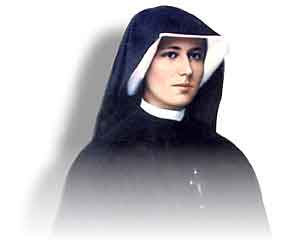 Saint Maria Faustina Kowalska –The Humble Instrument
Saint Maria Faustina Kowalska –The Humble Instrument
The article below is found on the Divine Mercy website – I highly encourage you to visit there (they are doing wonderful things)!
Sister Faustina was a young, uneducated, nun in a convent of the Congregation of Sisters of Our Lady of Mercy in Cracow, Poland during the 1930’s. She came from a very poor family that struggled on their little farm during the years of World War I. She had only three years of very simple education, so hers were the humblest tasks in the convent, usually in the kitchen or garden. However, she received extraordinary revelations or messages from Our Lord Jesus. Jesus asked Sr. Faustina to record these experiences, which she compiled in notebooks. These notebooks are known today as the Diary of Saint Maria Faustina Kowalska and the words contained within are God’s loving message of Divine Mercy. Though the Divine Mercy message is not new to the teachings of the Church, Sr. Faustina’s Diary sparked a great movement, and a strong and significant focus on the mercy of Christ. Pope John Paul II canonized Sr. Faustina in 2000 making her the “first saint of the new millennium.” Speaking of Sr. Faustina and the importance of the message contained in her Diary, the Pope call her “the great apostle of Divine Mercy in our time.” Today, we continue to rely of Saint Faustina as a constant reminder of the message to trust in Jesus’ endless mercy, and to live life mercifully toward others. We also turn to her in prayer and request her intercession to our merciful Savior on our behalf. At the National Shrine of The Divine Mercy, we include the following in our 3 o’clock prayers:
Saint Faustina,
You told us that your mission would continue after your death and that you would not forget us. Our Lord also granted you a great privilege, telling you to “distribute graces as you will, to who you will, and when you will.” Relying on this, we ask your intercession for the graces we need, especially for the intentions just mentioned. Help us, above all, to trust in Jesus as you did and thus to glorify His mercy every moment of our lives. Amen
–from DivineMercy.org
Here is my favorite (if that is possible) of the notebook V “Conversation” dialogues
The Diary of
St. Â M. Faustina Kowalska
Perpetually Professed member
of the
Congregation of Sisters of
Our Lady of Mercy
NOTEBOOK V
Conversation of the Merciful God with a Soul Striving after Perfection.
Jesus: I am pleased with your efforts, O soul aspiring for perfection, but why do I see you so often sad and depressed? Tell Me, My child, what is the meaning of this sadness, and what is its cause?
Soul: Lord, the reason for my sadness is that, in spite of my sincere resolutions, I fall again into the same faults. I make resolutions in the morning, but in the evening I see how much I have departed from them.
Jesus: You see what you are of yourself. The cause of your falls is that you rely too much upon yourself and too little on Me. But let this not sadden you so much. You are dealing with the God of mercy, which your misery cannot exhaust. Remember, I did not allot only a certain number of pardons.
Soul: Yes, I know all that but the great temptations assail me, and various doubts waken within me and moreover, everything irritates and discourages me.
Jesus: My child, know that the greatest obstacles to holiness are discouragement and an exaggerated anxiety. These will deprive you of the ability to practice virtue. All temptations united together ought not disturb your interior peace, not even momentarily. Sensitiveness and discouragement are fruits of self love. You should not become discouraged, but strive to make My love reign in place of your self love. Have confidence, My child. Do not lose heart in coming for pardon, for I am always ready to forgive you. As often as you beg for it, you glorify My mercy.
Soul: I understand what is the better thing to do, what pleases You more, but I encounter great obstacles in acting on this understanding.
Jesus: My child, life on earth is a struggle indeed; a great struggle for My kingdom. But fear not, because you are not alone. I am always supporting you, so lean on Me as you struggle, fearing nothing. Take the vessel of trust and draw from the fountain of life – for yourself, but also for other souls, especially such as are distrustful of My goodness.
Soul: O Lord, I feel my heart being filled with Your love and the rays of Your mercy and love piercing my soul. I go, Lord, at Your command. I go to conquer souls. Sustained by Your grace, I am ready to follow You Lord, not only to Tabor, but also to Calvary. I desire to lead souls to the fount of Your mercy so that the splendor of Your mercy may be reflected in all souls, and the home of our Father be filled to overflowing. And when the enemy begins to attack me, I shall take refuge behind the shield of Your mercy.
Pray the Divine Mercy Prayer [powerpress = “devotionals-prayers”]
The Discerning Hearts Divine Mercy Novena Page
Tags: catholic, catholic podcast, catholic prayer, cathollc spirituality, divine mercy, divine mercy message, Faustina Kowalska, john paul ii, mystic, mystic of the Church, national shrine of the divine mercy, Saint Faustina, saint maria faustina kowalska, Sister Faustina, st faustina
This entry was posted on Wednesday, October 5th, 2011 at 12:04 am
You can follow any responses to this entry through the RSS 2.0 feed.
Audio Prayer for the intercession of St.Padre Pio[powerpress]
“Pray, pray to the Lord with me, because the whole world needs prayer. And every day, when your heart especially feels the loneliness of life, pray. Pray to the Lord, because even God needs our prayers.”
Tags: catholic, catholic podcast, catholic prayer, cathollc spirituality, mp3 audio pray, mystic, mystic of the Church, padre pio
This entry was posted on Friday, September 23rd, 2011 at 12:01 am
You can follow any responses to this entry through the RSS 2.0 feed.
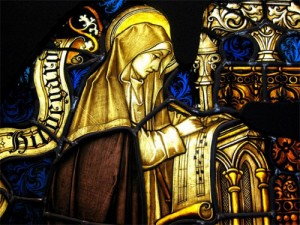 800+Â years later,
800+Â years later,
it still holds up….
now that’s the work of
the Holy Spirit!
Tags: catholic, catholic podcast, catholic prayer, cathollc spirituality, chant, mystic, mystic of the Church, st hildegard of bingen, st. hildegarde, women of the middle ages, work
This entry was posted on Saturday, September 17th, 2011 at 5:00 pm
You can follow any responses to this entry through the RSS 2.0 feed.
VATICAN CITY, 12 JAN 2011 (vatican.va) –
Dear Brothers and Sisters,
After Catherine of Siena and Catherine of Bologna, today I would like to speak to you about another Saint: Catherine of Genoa, known above all for her vision of purgatory. The text that describes her life and thought was published in this Ligurian city in 1551. It is in three sections: her Vita [Life], properly speaking, the Dimostratione et dechiaratione del purgatorio — better known as Treatise on purgatory — and her Dialogo tra l’anima e il corpo (cf. Libro de la Vita mirabile et dottrina santa, de la beata Caterinetta da Genoa. Nel quale si contiene una utile et catholica dimostratione et dechiaratione del purgatorio, Genoa 1551). The final version was written by Catherine’s confessor, Fr Cattaneo Marabotto.
Catherine was born in Genoa in 1447. She was the youngest of five. Her father, Giacomo Fieschi, died when she was very young. Her mother, Francesca di Negro provided such an effective Christian education that the elder of her two daughters became a religious.
When Catherine was 16, she was given in marriage to Giuliano Adorno, a man who after various trading and military experiences in the Middle East had returned to Genoa in order to marry.
Married life was far from easy for Catherine, partly because of the character of her husband who was given to gambling. Catherine herself was at first induced to lead a worldly sort of life in which, however, she failed to find serenity. After 10 years, her heart was heavy with a deep sense of emptiness and bitterness.
A unique experience on 20 March 1473 sparked her conversion. She had gone to the Church of San Benedetto in the monastery of Nostra Signora delle Grazie [Our Lady of Grace], to make her confession and, kneeling before the priest, “receivedâ€, as she herself wrote, “a wound in my heart from God’s immense loveâ€. It came with such a clear vision of her own wretchedness and shortcomings and at the same time of God’s goodness, that she almost fainted.
Her heart was moved by this knowledge of herself — knowledge of the empty life she was leading and of the goodness of God. This experience prompted the decision that gave direction to her whole life. She expressed it in the words: “no longer the world, no longer sin†(cf. Vita Mirabile, 3rv). Catherine did not stay to make her Confession.
On arriving home she entered the remotest room and spent a long time weeping. At that moment she received an inner instruction on prayer and became aware of God’s immense love for her, a sinner. It was a spiritual experience she had no words to  describe ( cf. Vita Mirabile, 4r).
It was on this occasion that the suffering Jesus appeared to her, bent beneath the Cross, as he is often portrayed in the Saint’s iconography. A few days later she returned to the priest to make a good confession at last. It was here that began the “life of purification†which for many years caused her to feel constant sorrow for the sins she had committed and which spurred her to impose forms of penance and sacrifice upon herself, in order to show her love to God.
On this journey Catherine became ever closer to the Lord until she attained what is called “unitive lifeâ€, namely, a relationship of profound union with God.
In her Vita it is written that her soul was guided and instructed from within solely by the sweet love of God which gave her all she needed. Catherine surrendered herself so totally into the hands of the Lord that she lived, for about 25 years, as she wrote, “without the assistance of any creature, taught and governed by God alone†(Vita, 117r-118r), nourished above all by constant prayer and by Holy Communion which she received every day, an unusual practice in her time. Only many years later did the Lord give her a priest who cared for her soul.
Catherine was always reluctant to confide and reveal her experience of mystical communion with God, especially because of the deep humility she felt before the Lord’s graces. The prospect of glorifying him and of being able to contribute to the spiritual journey of others alone spurred her to recount what had taken place within her, from the moment of her conversion, which is her original and fundamental experience.
The place of her ascent to mystical peaks was Pammatone Hospital, the largest hospital complex in Genoa, of which she was director and animator. Hence Catherine lived a totally active existence despite the depth of her inner life. In Pammatone a group of followers, disciples and collaborators formed around her, fascinated by her life of faith and her charity.
Indeed her husband, Giuliano Adorno, was so so won over that he gave up his dissipated life, became a Third Order Franciscan and moved into the hospital to help his wife.
Catherine’s dedication to caring for the sick continued until the end of her earthly life on 15 September 1510. From her conversion until her death there were no extraordinary events but two elements characterize her entire life: on the one hand her mystical experience, that is, the profound union with God, which she felt as spousal union, and on the other, assistance to the sick, the organization of the hospital and service to her neighbour, especially the neediest and the most forsaken. These two poles, God and neighbour, totally filled her life, virtually all of which she spent within the hospital walls.
Dear friends, we must never forget that the more we love God and the more constantly we pray, the better we will succeed in truly loving those who surround us, who are close to us, so that we can see in every person the Face of the Lord whose love knows no bounds and makes no distinctions. The mystic does not create distance from others or an abstract life, but rather approaches other people so that they may begin to see and act with God’s eyes and heart.
Catherine’s thought on purgatory, for which she is particularly well known, is summed up in the last two parts of the book mentioned above: The Treatise on purgatory and the Dialogues between the body and the soul. It is important to note that Catherine, in her mystical experience, never received specific revelations on purgatory or on the souls being purified there. Yet, in the writings inspired by our Saint, purgatory is a central element and the description of it has characteristics that were original in her time.
The first original passage concerns the “place†of the purification of souls. In her day it was depicted mainly using images linked to space: a certain space was conceived of in which purgatory was supposed to be located.
Catherine, however, did not see purgatory as a scene in the bowels of the earth: for her it is not an exterior but rather an interior fire. This is purgatory: an inner fire.
The Saint speaks of the Soul’s journey of purification on the way to full communion with God, starting from her own experience of profound sorrow for the sins committed, in comparison with God’s infinite love (cf. Vita Mirabile, 171v).
We heard of the moment of conversion when Catherine suddenly became aware of God’s goodness, of the infinite distance of her own life from this goodness and of a burning fire within her. And this is the fire that purifies, the interior fire of purgatory. Here too is an original feature in comparison with the thought of her time.
In fact, she does not start with the afterlife in order to recount the torments of purgatory — as was the custom in her time and perhaps still is today — and then to point out the way to purification or conversion. Rather our Saint begins with the inner experience of her own life on the way to Eternity.
“The soulâ€, Catherine says, “presents itself to God still bound to the desires and suffering that derive from sin and this makes it impossible for it to enjoy the beatific vision of Godâ€. Catherine asserts that God is so pure and holy that a soul stained by sin cannot be in the presence of the divine majesty (cf. Vita Mirabile, 177r).
We too feel how distant we are, how full we are of so many things that we cannot see God. The soul is aware of the immense love and perfect justice of God and consequently suffers for having failed to respond in a correct and perfect way to this love; and love for God itself becomes a flame, love itself cleanses it from the residue of sin.
In Catherine we can make out the presence of theological and mystical sources on which it was normal to draw in her time. In particular, we find an image typical of Dionysius the Areopagite: the thread of gold that links the human heart to God himself. When God purified man, he bound him with the finest golden thread, that is, his love, and draws him toward himself with such strong affection that man is as it were “overcome and won over and completely beside himselfâ€.
Thus man’s heart is pervaded by God’s love that becomes the one guide, the one driving force of his life (cf. Vita Mirabile, 246rv). This situation of being uplifted towards God and of surrender to his will, expressed in the image of the thread, is used by Catherine to express the action of divine light on the souls in purgatory, a light that purifies and raises them to the splendour of the shining radiance of God (cf. Vita Mirabile, 179r).
Dear friends, in their experience of union with God, Saints attain such a profound knowledge of the divine mysteries in which love and knowledge interpenetrate, that they are of help to theologians themselves in their commitment to study, to intelligentia fidei, to an intelligentia of the mysteries of faith, to attain a really deeper knowledge of the mysteries of faith, for example, of what purgatory is.
With her life St Catherine teaches us that the more we love God and enter into intimacy with him in prayer the more he makes himself known to us, setting our hearts on fire with his love.
In writing about purgatory, the Saint reminds us of a fundamental truth of faith that becomes for us an invitation to pray for the deceased so that they may attain the beatific vision of God in the Communion of Saints (cf. Catechism of the Catholic Church, n. 1032).
Moreover the humble, faithful and generous service in Pammatone Hospital that the Saint rendered throughout her life is a shining example of charity for all and an encouragement, especially for women who, with their precious work enriched by their sensitivity and attention to the poorest and neediest, make a fundamental contribution to society and to the Church. Many thanks.
For more on St. Catherine of Genoa visit Discerning Hearts post St. Catherine of Genoa…it’s all about Divine Love
Tags: benedict xvi, Catherine of Genoa, catholic, catholic podcast, catholic prayer, cathollc spirituality, experience, love, mystic, mystic of the Church, mystical communion, mystical experience, purgatory, relationship, souls in purgatory, st catherine of genoa, Vita Mirabile, women of the middle ages
This entry was posted on Wednesday, January 12th, 2011 at 1:01 pm
You can follow any responses to this entry through the RSS 2.0 feed.
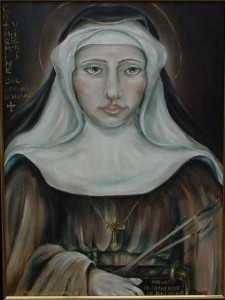 Patroness of Artists and Against Spiritual Temptation
Patroness of Artists and Against Spiritual Temptation
VATICAN CITY, 29 DEC 2010 (vatican.va) –
Dear Brothers and Sisters,
In a recent Catechesis I spoke of St Catherine of Siena. Today I would like to present to you another less well known Saint who has the same name: St Catherine of Bologna, a very erudite yet very humble woman. She was dedicated to prayer but was always ready to serve; generous in sacrifice but full of joy in welcoming Christ with the Cross. Catherine was born in Bologna on 8 September 1413, the eldest child of Benvenuta Mammolini and John de’ Vigri, a rich and cultured patrician of Ferrara, a doctor in law and a public lector in Padua, where he carried out diplomatic missions for Nicholas III d’Este, Marquis of Ferrara.
Not much information about Catherine’s infancy and childhood is available and not all of it is reliable. As a child she lived in her grandparents’ house in Bologna, where she was brought up by relatives, especially by her mother who was a woman of deep faith. With her, Catherine moved to Ferrara when she was about 10 years old and entered the court of Nicholas III d’Este as lady-in-waiting to Margaret, Nicholas’ illegitimate daughter. The Marquis was transforming Ferrara into a fine city, summoning artists and scholars from various countries. He encouraged culture and, although his private life was not exemplary, took great care of the spiritual good, moral conduct and education of his subjects. In Ferrara Catherine was unaware of the negative aspects that are often part and parcel of court life. She enjoyed Margaret’s friendship and became her confidante. She developed her culture by studying music, painting and dancing; she learned to write poetry and literary compositions and to play the viola; she became expert in the art of miniature-painting and copying; she perfected her knowledge of Latin. In her future monastic life she was to put to good use the cultural and artistic heritage she had acquired in these years. She learned with ease, enthusiasm and tenacity. She showed great prudence, as well as an unusual modesty, grace and kindness in her behaviour. However, one absolutely clear trait distinguished her: her spirit, constantly focused on the things of Heaven. In 1427, when she was only 14 years old and subsequent to certain family events, Catherine decided to leave the court to join a group of young noble women who lived a community life dedicating themselves to God. Her mother trustingly consented in spite of having other plans for her daughter. We know nothing of Catherine’s spiritual path prior to this decision. Speaking in the third person, she states that she entered God’s service, “illumined by divine grace… with an upright conscience and great fervourâ€, attentive to holy prayer by night and by day, striving to acquire all the virtues she saw in others, “not out of envy but the better to please God in whom she had placed all her love†(Le sette armi necessarie alla battaglia spirituali, [The seven spiritual weapons], VII, 8, Bologna 1998, p. 12). She made considerable spiritual progress in this new phase of her life but her trials, her inner suffering and especially the temptations of the devil were great and terrible. She passed through a profound spiritual crisis and came to the brink of despair (cf. ibid., VII, 2, pp. 12-29). She lived in the night of the spirit, and was also deeply shaken by the temptation of disbelief in the Eucharist.
After so much suffering, the Lord comforted her: he gave her, in a vision, a clear awareness of the Real Presence in the Eucharist, an awareness so dazzling that Catherine was unable to express it in words (cf. ibid., VIII, 2. pp. 42-46).
In this same period a sorrowful trial afflicted the community: tension arose between those who wished to follow the Augustinian spirituality and those who had more of an inclination for Franciscan spirituality. Between 1429 and 1430, Lucia Mascheroni, in charge of the group, decided to found an Augustinian monastery. Catherine, on the other hand chose with others to bind herself to the Rule of St Clare of Assisi. It was a gift of Providence, because the community dwelled in the vicinity of the Church of the Holy Spirit, annexed to the convent of the Friars Minor who had adhered to the movement of the Observance. Thus Catherine and her companions could take part regularly in liturgical celebrations and receive adequate spiritual assistance. They also had the joy of listening to the preaching of St Bernardine of Siena (cf. ibid., VII, 62, p. 26). Catherine recounts that in 1429 — the third year since her conversion — she went to make her confession to one of the Friars Minor whom she esteemed, she made a good Confession and prayed the Lord intensely to grant her forgiveness for all her sins and the suffering connected with them.
In a vision God revealed to her that he had forgiven her everything. It was a very strong experience of divine mercy which left an indelible mark upon her, giving her a fresh impetus to respond generously to God’s immense love (cf. ibid. IX, 2, pp. 46-48).
In 1431 she had a vision of the Last Judgement. The terrifying spectacle of the damned impelled her to redouble her prayers and penance for the salvation of sinners. The devil continued to assail her and she entrusted herself ever more totally to the Lord and to the Virgin Mary (cf. ibid., X, 3, pp. 53-54). In her writings, Catherine has left us a few essential notes concerning this mysterious battle from which, with God’s grace, she emerged victorious. She did so in order to instruct her sisters and those who intend to set out on the path of perfection: she wanted to put them on their guard against the temptations of the devil who often conceals himself behind deceptive guises, later to sow doubts about faith, vocational uncertainty and sensuality. In her autobiographical and didactic treatise, The Seven Spiritual Weapons, Catherine offers in this regard teaching of deep wisdom and profound discernment. She speaks in the third person in reporting the extraordinary graces which the Lord gives to her and in the first person in confessing her sins. From her writing transpires the purity of her faith in God, her profound humility, the simplicity of her heart, her missionary zeal, her passion for the salvation of souls. She identifies seven weapons in the fight against evil, against the devil:
1. always to be careful and diligently strive to do good;
2. to believe that alone we will never be able to do something truly good;
3. to trust in God and, for love of him, never to fear in the battle against evil, either in the world or within ourselves;
4. to meditate often on the events and words of the life of Jesus, and especially on his Passion and his death;
5. to remember that we must die;
6. to focus our minds firmly on memory of the goods of Heaven;
7. to be familiar with Sacred Scripture, always cherishing it in our hearts so that it may give direction to all our thoughts and all our actions.
A splendid programme of spiritual life, today too, for each one of us!
In the convent Catherine, in spite of being accustomed to the court in Ferrara, served in the offices of laundress, dressmaker and breadmaker and even looked after the animals. She did everything, even the lowliest tasks, with love and ready obedience, offering her sisters a luminous witness. Indeed she saw disobedience as that spiritual pride which destroys every other virtue. Out of obedience she accepted the office of novice mistress, although she considered herself unfit for this office, and God continued to inspire her with his presence and his gifts: in fact she proved to be a wise and appreciated mistress. Later the service of the parlour was entrusted to her. She found it trying to have to interrupt her prayers frequently in order to respond to those who came to the monastery grill, but this time too the Lord did not fail to visit her and to be close to her. With her the monastery became an increasingly prayerful place of self-giving, of silence, of endeavour and of joy. Upon the death of the abbess, the superiors thought immediately of her, but Catherine urged them to turn to the Poor Clares of Mantua who were better instructed in the Constitutions and in religious observance. Nevertheless, a few years later, in 1456, she was asked at her monastery to open a new foundation in Bologna. Catherine would have preferred to end her days in Ferrara, but the Lord appeared to her and exhorted her to do God’s will by going to Bologna as abbess. She prepared herself for the new commitment with fasting, scourging and penance. She went to Bologna with 18 sisters. As superior she set the example in prayer and in service; she lived in deep humility and poverty. At the end of her three-year term as abbess she was glad to be replaced but after a year she was obliged to resume her office because the newly elected abbess became blind. Although she was suffering and and was afflicted with serious ailments that tormented her, she carried out her service with generosity and dedication. For another year she urged her sisters to an evangelical life, to patience and constancy in trial, to fraternal love, to union with the divine Bridegroom, Jesus, so as to prepare her dowry for the eternal nuptials. It was a dowry that Catherine saw as knowing how to share the sufferings of Christ, serenely facing hardship, apprehension, contempt and misunderstanding (cf. Le sette armi spirituali, X, 20, pp. 57-58). At the beginning of 1463 her health deteriorated. For the last time she gathered the sisters in Chapter, to announce her death to them and to recommend the observance of the Rule. Towards the end of February she was harrowed by terrible suffering that was never to leave her, yet despite her pain it was she who comforted her sisters, assuring them that she would also help them from Heaven. After receiving the last Sacraments, she give her confessor the text she had written: The Seven Spiritual Weapons, and entered her agony; her face grew beautiful and translucent; she still looked lovingly at those who surrounded her and died gently, repeating three times the name of Jesus. It was 9 March 1463 (cf. I. Bembo, Specchio di illuminazione, Vita di S. Caterina a Bologna,Florence 2001, chap. III). Catherine was to be canonized by Pope Clement XI on 22 May 1712. Her incorrupt body is preserved in the city of Bologna, in the chapel of the monastery of Corpus Domini. Dear friends, with her words and with her life, St Catherine of Bologna is a pressing invitation to let ourselves always be guided by God, to do his will daily, even if it often does not correspond with our plans, to trust in his Providence which never leaves us on our own. In this perspective, St Catherine speaks to us; from the distance of so many centuries she is still very modern and speaks to our lives.
She, like us, suffered temptations, she suffered the temptations of disbelief, of sensuality, of a difficult spiritual struggle. She felt forsaken by God, she found herself in the darkness of faith. Yet in all these situations she was always holding the Lord’s hand, she did not leave him, she did not abandon him. And walking hand in hand with the Lord, she walked on the right path and found the way of light.
So it is that she also tells us: take heart, even in the night of faith, even amidst our many doubts, do not let go of the Lord’s hand, walk hand in hand with him, believe in God’s goodness. This is how to follow the right path!
And I would like to stress another aspect: her great humility. She was a person who did not want to be someone or something; she did not care for appearances, she did not want to govern. She wanted to serve, to do God’s will, to be at the service of others. And for this very reason Catherine was credible in her authority, because she was able to see that for her authority meant, precisely, serving others.
Let us ask God, through the intercession of Our Saint, for the gift to achieve courageously and generously the project he has for us, so that he alone may be the firm rock on which our lives are built. Thank you.
Tags: Bologna, catholic, catholic podcast, catholic prayer, cathollc spirituality, evil, faith, franciscan spirituality, mystic of the Church, poor clares, pope benedict xvi, Saint Catherine, spiritual weapons, st catherine of bologna, suffering, temptations, women of the middle ages
This entry was posted on Thursday, December 30th, 2010 at 5:53 am
You can follow any responses to this entry through the RSS 2.0 feed.
“In an instant, I saw five brilliant rays of light shine forth from his most holy wounds, and all came to my face.” St. Veronica Giuliani wrote these words more than three centuries ago, describing her mystical experience of Christ.
Vatican City, Dec 15, 2010 / 07:37 pm (vatican.va).-
Dear Brothers and Sisters,
Today I would like to present a mystic who did not live in the Middle Ages. She is St Veronica Giuliani, a Poor Clare Capuchin nun. The reason is that 27 December will be the 350th anniversary of her birth. Città di Castello, the place where she lived the longest and where she died, as well as Mercatello — her birthplace — and the Diocese of Urbino are celebrating this event with joy.
Indeed, Veronica was born on 27 December 1660 in Mercatello, in the Metauro Valley to Francesco Giuliani and Benedetta Mancini. She was the last of seven sisters, three of whom were to embrace the monastic life.
She was given the name “Orsola†[Ursula]. She was seven years old when her mother died and her father moved to Piacenza as customs superintendent of the Duchy of Parma. It was in this city that Ursula felt a growing desire to dedicate her life to Christ. The call to her became ever more pressing so that, when she was 17, she entered the strict cloister of the monastery of Capuchin Poor Clares in Città di Castello. She was to remain here for the rest of her life. Here she received the name of “Veronicaâ€, which means “true image†and she was in fact to become a true image of the Crucified Christ.
A year later she made her solemn religious profession and the process of configuration to Christ began for her, through much penance, great suffering, and several mystic experiences linked to the Passion of Jesus: being crowned with thorns, the mystical espousal, the wound in her heart and the stigmata.
In 1716, when she was 56, she became Abbess of the monastery. She was reconfirmed in this office until her death in 1727, after a very painful prolonged agony that lasted 33 days and culminated in a joy so profound that her last words were: “I have found Love, Love has let himself be seen! This is the cause of my suffering. Tell everyone about it, tell everyone!†(Summarium Beatificationis, 115-120).
On 9 July she left her earthly dwelling place for the encounter with God. She was 67 years old; 50 of those years she spent in the monastery of Città di Castello. She was canonized on May 26, 1893, by Pope Gregory XVI.
Veronica Giuliani wrote prolifically: letters, autobiographical reports, poems. However, the main source for reconstructing her thought is her Diary, which she began in 1693: about 22,000 handwritten pages that cover a span of 34 years of cloistered life.
Her writing flows spontaneously and continuously. There are no crossings-out, corrections or punctuation marks in it, nor was the material divided into chapters or parts according to a plan.
Veronica did not intend to compose a literary work; on the contrary, Fr Girolamo Bastianelli, a Filippini religious, in agreement with the diocesan Bishop Antonio Eustachi, obliged her to set down her experiences in writing.
St Veronica has a markedly Christological and spousal spirituality: She experienced being loved by Christ, her faithful and sincere Bridegroom, to whom she wished to respond with an ever more involved and passionate love. She interpreted everything in the key of love and this imbued her with deep serenity. She lived everything in union with Christ, for love of him, and with the joy of being able to demonstrate to him all the love of which a creature is capable.
The Christ to whom Veronica was profoundly united was the suffering Christ of the Passion, death and Resurrection; it was Jesus in the act of offering himself to the Father in order to save us.
Her intense and suffering love for the Church likewise stemmed from this experience, in its dual form of prayer and offering. The Saint lived in this perspective: she prayed, suffered and sought “holy povertyâ€, as one “dispossessed†and the loss of self (cf. ibid., III, 523), precisely in order to be like Christ who gave the whole of himself.
In every page of her writings Veronica commends someone to the Lord, reinforcing her prayers of intercession with the offering of herself in every form of suffering. Her heart dilated to embrace all “the needs of the Holy Churchâ€, living anxiously the desire for the salvation of “the whole world†(ibid., III-IV, passim).
Veronica cried: “O sinners… all men and all women, come to Jesus’ heart; come to be cleansed by his most precious blood…. He awaits you with open arms to embrace you†(ibid., II, 16-17).
Motivated by ardent love, she gave her sisters in the monastery attention, understanding and forgiveness. She offered her prayers and sacrifices for the Pope, for her Bishop, for priests and for all those in need, including the souls in Purgatory.
She summed up her contemplative mission in these words: “We cannot go about the world preaching to convert souls but are bound to pray ceaselessly for all those souls who are offending God… particularly with our sufferings, that is, with a principle of crucified life†(ibid., IV, 877). Our Saint conceived this mission as “being in the midst†of men and God, of sinners and the Crucified Christ.
Veronica lived profound participation in the suffering love of Jesus, certain that “to suffer with joy†is the “key to love†(cf. ibid., I, 299.417; III, 330.303.871; IV, 192). She emphasizes that Jesus suffers for humanity’s sins, but also for the suffering that his faithful servants would have to endure down the centuries, in the time of the Church, precisely because of their solid and consistent faith.
She wrote: “His Eternal Father made them see and feel the extent of all the suffering that his chosen ones would have to endure, the souls dearest to him, that is, those who would benefit from his Blood and from all his sufferings” (ibid., II, 170).
As the Apostle Paul says of himself: “Now I rejoice in my sufferings for your sake, and in my flesh I complete what is lacking in Christ’s afflictions for the sake of his Body, that is, the Church†(Col 1:24).
Veronica reached the point of asking Jesus to be crucified with him. “In an instantâ€, she wrote, “I saw five radiant rays issue from his most holy wounds; and they all shone on my face. And I saw these rays become, as it were, little tongues of fire. In four of them were the nails; and in one was the spear, as of gold, red hot and white hot: and it went straight through my heart, from one side to the other … and the nails pierced my hands and feet. I felt great pain but in this same pain I saw myself, I felt myself totally transformed into God†(Diary, I, 897).
The Saint was convinced that she was already participating in the Kingdom of God, but at the same time she invoked all the Saints of the Blessed Homeland to come to her aid on the earthly journey of her self-giving while she waited for eternal beatitude; this was her undying aspiration throughout her life (cf. ibid., II, 909; V, 246).
With regard to the preaching of that time which often focused on “saving one’s soul†in individual terms, Veronica shows a strong “sense of solidarityâ€, a sense of communion with all her brothers and sisters on their way towards Heaven and she lives, prays and suffers for all. The penultimate, earthly things, although appreciated in the Franciscan sense as gifts of the Creator, were always relative, altogether subordinate to “God’s taste†and under the sign of radical poverty.
In the communio sanctorum, she explains the gift of herself to the Church, as the relationship between the pilgrim Church and the heavenly Church. “All the Saintsâ€, she wrote, “are up there thanks to the merit and the Passion of Jesus; but they cooperated with all that the Lord did, so that their life was totally ordered … regulated by these same works (his)†(ibid., III, 203).
We find many biblical citations in Veronica’s writings, at times indirectly, but always precise. She shows familiarity with the Sacred Text, by which her spiritual experience was nourished. Furthermore, it should be pointed out that the intense moments of Veronica’s mystical experience are never separate from the salvific events celebrated in the Liturgy, where the proclamation of the Word of God and listening to it has a special place. Hence Sacred Scripture illumines, purifies and confirms Veronica’s experience, rendering it ecclesial. On the other hand, however, her experience itself, anchored in Sacred Scripture with uncommon intensity, guides one to a more profound and “spiritual†reading of the text itself, to enter into its hidden depths. Not only does she express herself with the words of Sacred Scripture but she also really lives by them, they take on life in her.
For example, our Saint often quotes the words of the Apostle Paul: “If God is for us, who is against us?†(Rom 8:31; cf. Diary, I, 714; II 116.1021; III, 48).
The assimilation of this Pauline text, her great trust and profound joy, becomes a fait accompliwithin her. “My soulâ€, she wrote, “was bound to the divine will and I was truly established and fixed for ever in the will of God. It seemed to me that I should never again have to be separated from this will of God and I came to myself with these precise words: nothing will be able to separate me from the will of God, neither anxieties, nor sorrows nor toil nor contempt nor temptation nor creatures nor demons nor darkness, not even death itself, because, in life and in death, I want all, and in all things, the will of God†(Diary, IV, 272). Thus we have the certainty that death is not the last word, we are fixed in God’s will, hence, truly, in eternal life.
In particular, Veronica proved a courageous witness of the beauty and power of Divine Love which attracted her, pervaded her and inflamed her. Crucified Love was impressed within her flesh as it was in that of St Francis of Assisi, with Jesus’ stigmata. “‘My Bride’, the Crucified Christ whispers to me, ‘the penance you do for those who suffer my disgrace is dear to me’…. Then detaching one of his arms from the Cross he made a sign to me to draw near to his side… and I found myself in the arms of the Crucified One. What I felt at that point I cannot describe: I should have liked to remain for ever in his most holy side†(ibid., I, 37).
This is also an image of her spiritual journey, of her interior life: to be in the embrace of the Crucified One and thus to remain in Christ’s love for others.
Veronica also experienced a relationship of profound intimacy with the Virgin Mary, attested by the words she heard Our Lady say one day, which she reports in her Diary: “I made you rest on my breast, you were united with my soul, and from it you were taken as in flight to God†(IV, 901).
St Veronica Giuliani invites us to develop, in our Christian life, our union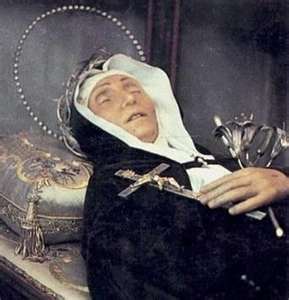 with the Lord in living for others, abandoning ourselves to his will with complete and total trust, and the union with the Church, the Bride of Christ.
with the Lord in living for others, abandoning ourselves to his will with complete and total trust, and the union with the Church, the Bride of Christ.
She invites us to participate in the suffering love of Jesus Crucified for the salvation of all sinners; she invites us to fix our gaze on Heaven, the destination of our earthly journey, where we shall live together with so many brothers and sisters the joy of full communion with God; she invites us to nourish ourselves daily with the Word of God, to warm our hearts and give our life direction. The Saint’s last words can be considered the synthesis of her passionate mystical experience: “I have found Love, Love has let himself be seen!â€. Thank you.
Tags: beauty, catholic, catholic podcast, catholic prayer, cathollc spirituality, christ in his suffering, Church, holy wounds, Jesus, mystic, mystic of the Church, mystical experiences, pope benedict, union with christ, veronica giuliani, witness
This entry was posted on Thursday, December 16th, 2010 at 6:03 am
You can follow any responses to this entry through the RSS 2.0 feed.
Thank you Terry Fenwick…
Tags: catholic, catholic podcast, catholic prayer, cathollc spirituality, felicity, martyr, mystic, mystic of the Church, perpetua, song
This entry was posted on Thursday, December 2nd, 2010 at 1:19 pm
You can follow any responses to this entry through the RSS 2.0 feed.
“God’s Promises Are Always Greater Than Our Hopes”
VATICAN CITY, DEC. 1, 2010 (vatican.va).- Here is a translation of the address Benedict XVI gave today during the general audience in Paul VI Hall.
Dear Brothers and Sisters,
I still remember with great joy the Apostolic Journey I made in the United Kingdom last September. England is a land that has given birth to a great many distinguished figures who enhanced Church history with their testimony and their teaching. One of them, venerated both in the Catholic Church and in the Anglican Communion, is the mystic Julian of Norwich, of whom I wish to speak this morning.
The — very scant — information on her life in our possession comes mainly from her Revelations of Divine Love in Sixteen Showings, the book in which this kindly and devout woman set down the content of her visions.
It is known that she lived from 1342 until about 1430, turbulent years both for the Church, torn by the schism that followed the Pope’s return to Rome from Avignon, and for the life of the people who were suffering the consequences of a long drawn-out war between the Kingdoms of England and of France. God, however, even in periods of tribulation, does not cease to inspire figures such as Julian of Norwich, to recall people to peace, love and joy.
As Julian herself recounts, in May 1373, most likely on the 13th of that month, she was suddenly stricken with a very serious illness that in three days seemed to be carrying her to the grave. After the priest, who hastened to her bedside, had shown her the Crucified One not only did Julian rapidly recover her health but she received the 16 revelations that she subsequently wrote down and commented on in her book, Revelations of Divine Love.
And it was the Lord himself, 15 years after these extraordinary events, who revealed to
her the meaning of those visions.
“‘Would you learn to see clearly your Lord’s meaning in this thing? Learn it well: Love was his meaning. Who showed it to you? Love…. Why did he show it to you? For Love’…. Thus I was taught that Love was our Lord’s meaning†(Julian of Norwich, Revelations of Divine Love,Chapter 86).
Inspired by divine love, Julian made a radical decision. Like an ancient anchoress, she decided to live in a cell located near the church called after St Julian, in the city of Norwich — in her time an important urban centre not far from London.
She may have taken the name of Julian precisely from that Saint to whom was dedicated the church in whose vicinity she lived for so many years, until her death.
This decision to live as a “recluseâ€, the term in her day, might surprise or even perplex us. But she was not the only one to make such a choice. In those centuries a considerable number of women opted for this form of life, adopting rules specially drawn up, for them, such as the rule compiled by St Aelred of Rievaulx.
The anchoresses or “reclusesâ€, in their cells, devoted themselves to prayer, meditation and study. In this way they developed a highly refined human and religious sensitivity which earned them the veneration of the people. Men and women of every age and condition in need of advice and comfort, would devoutly seek them. It was not, therefore, an individualistic choice; precisely with this closeness to the Lord, Julian developed the ability to be a counsellor to a great many people and to help those who were going through difficulties in this life.
We also know that Julian too received frequent visitors, as is attested by the autobiography of another fervent Christian of her time, Margery Kempe, who went to Norwich in 1413 to receive advice on her spiritual life. This is why, in her lifetime, Julian was called “Dame Julianâ€, as is engraved on the funeral monument that contains her remains. She had become a mother to many.
Men and women who withdraw to live in God’s company acquire by making this decision a great sense of compassion for the suffering and weakness of others. As friends of God, they have at their disposal a wisdom that the world — from which they have distanced themselves — does not possess and they amiably share it with those who knock at their door.
I therefore recall with admiration and gratitude the women and men’s cloistered monasteries. Today more than ever they are oases of peace and hope, a precious treasure for the whole Church, especially since they recall the primacy of God and the importance, for the journey of faith, of constant and intense prayer.
It was precisely in the solitude infused with God that Julian of Norwich wrote her Revelations of Divine Love. Two versions have come down to us, one that is shorter, probably the older, and one that is longer. This book contains a message of optimism based on the certainty of being loved by God and of being protected by his Providence.
In this book we read the following wonderful words: “And I saw full surely that ere God made us he loved us; which love was never lacking nor ever shall be. And in this love he has made all his works; and in this love he has made all things profitable to us; and in this love our life is everlasting… in which love we have our beginning. And all this shall we see in God, without end†(Revelations of Divine Love, Chapter 86).
The theme of divine love recurs frequently in the visions of Julian of Norwich who, with a certain daring, did not hesitate to compare them also to motherly love. This is one of the most characteristic messages of her mystical theology.
The tenderness, concern and gentleness of God’s kindness to us are so great that they remind us, pilgrims on earth, of a mother’s love for her children. In fact the biblical prophets also sometimes used this language that calls to mind the tenderness, intensity and totality of God’s love, which is manifested in creation and in the whole history of salvation that is crowned by the Incarnation of the Son.
God, however, always excels all human love, as the Prophet Isaiah says: “Can a woman forget her sucking child, that she should have no compassion on the son of her womb? Even these may forget, yet I will never forget you†(Is 49:15).
Julian of Norwich understood the central message for spiritual life:
God is love and it is only if one opens oneself to this love, totally and with total trust, and lets it become one’s sole guide in life, that all things are transfigured, true peace and true joy found and one is able to radiate it.
I would like to emphasize another point. The Catechism of the Catholic Church cites the words of Julian of Norwich when it explains the viewpoint of the Catholic faith on an argument that never ceases to be a provocation to all believers (cf. nn. 304-313, 314).
If God is supremely good and wise, why do evil and the suffering of innocents exist? And the Saints themselves asked this very question. Illumined by faith, they give an answer that opens our hearts to trust and hope: in the mysterious designs of Providence, God can draw a greater good even from evil, as Julian of Norwich wrote: “Here I was taught by the grace of God that I should steadfastly hold me in the Faith … and that … I should take my stand on and earnestly believe in … that ‘all manner of thing shall be wellâ€â€™ (The Revelations of Divine Love, Chapter 32).
Yes, dear brothers and sisters, God’s promises are ever greater than our expectations. If we present to God, to his immense love, the purest and deepest desires of our heart, we shall never be disappointed. “And all will be wellâ€, “all manner of things shall be wellâ€: this is the final message that Julian of Norwich transmits to us and that I am also proposing to you today. Many thanks.
Tags: anglican communion, benedict xvi, catholic, catholic podcast, catholic prayer, cathollc spirituality, julian of norwich, mystic, mystic of the Church, mystical experiences, Norwich, women of the middle ages
This entry was posted on Wednesday, December 1st, 2010 at 7:04 pm
You can follow any responses to this entry through the RSS 2.0 feed.


